For sun-powered baking, you'll want to use pans with depths between 1-2 inches for ideal performance. These shallow depths maximize heat absorption and guarantee even cooking temperatures throughout your food. Your pan material matters too – aluminum and dark-colored metals work best for efficient heat distribution. Avoid deep pans over 3 inches, as they create cold spots and require longer cooking times. You'll need to adjust cooking durations to 2-4 times longer than conventional methods and rotate your pan every 30-45 minutes for best sun exposure. Understanding the science behind pan depth can transform your solar cooking results.
Understanding Optimal Pan Depth Measurements
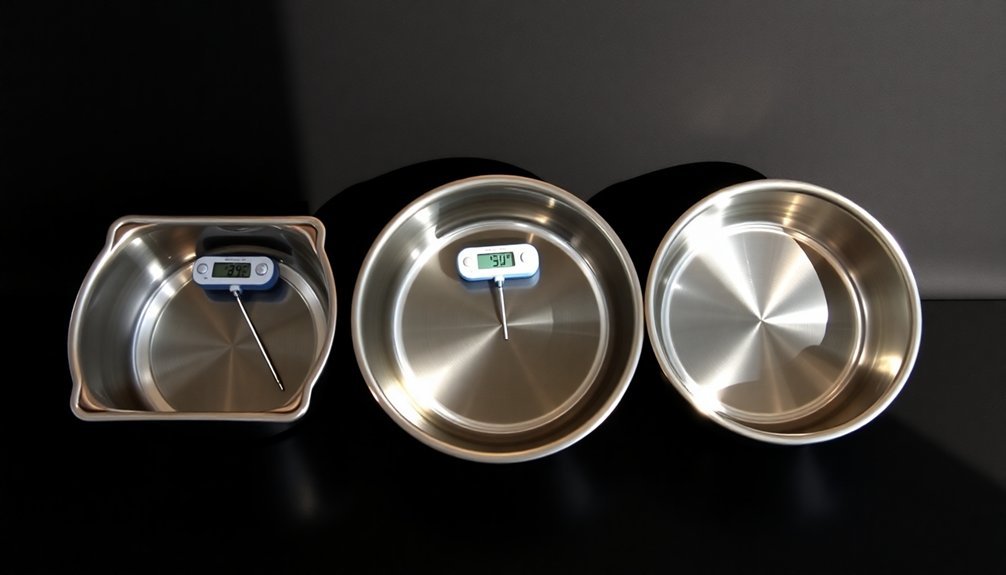
When you're selecting the perfect cooking pan, understanding how to measure depth accurately is essential for both cooking performance and recipe success.
You'll need a ruler or measuring tape and a straight edge to get precise measurements. Place your pan on a flat surface and measure vertically from the bottom to the top edge through the center point.
Focus on the internal height, excluding the pan's exterior thickness or flared edges. Most medium skillets measure 2 to 3 inches deep, but depths vary by pan type. Using non-permanent marker can help you mark key measurement points for clarity.
Remember that accurate depth measurements affect your pan's capacity, heat distribution, and cooking technique options. You'll want to take into account the thickness of the pan's bottom when calculating internal height, as this impacts both cooking performance and heat conductivity.
Shallow Pan Heat Distribution Benefits
Shallow pans' design helps you achieve superior cooking results through their optimized heat absorption properties.
You'll notice faster heating times due to the pan's minimal depth, which allows heat to spread quickly and evenly across the cooking surface.
The pan's shallow profile works with your heat source to eliminate hot spots and create consistent temperatures throughout the cooking area. The wide surface area provides maximum exposure to heat for perfectly even cooking results.
Fast Heat Absorption Science
Understanding the science of heat absorption reveals why shallow pans excel at distributing heat quickly and evenly across their cooking surfaces.
You'll find that pans with depths of 1-2 inches promote ideal heat absorption due to their wide surface area and enhanced air circulation.
When you're selecting materials, aluminum pans offer superior thermal conductivity, while stainless steel provides efficient heat distribution. Professional-grade aluminum pans with PFOA-free nonstick coating ensure safe and efficient cooking performance.
You can boost heat absorption by using black pots or applying black paint to the exterior, especially in solar cooking.
High-tech features like patented heat exchanger bases can speed up heating by 30-50%.
For sun-powered baking, shallow pans combined with reflectors and temperature oven bags create an efficient cooking system that maximizes heat retention while maintaining consistent temperatures throughout your cooking surface.
Even Cooking Through Design
Through innovative design principles, shallow pans deliver superior heat distribution that transforms your cooking experience. You'll find that the 1-2 inch depth combined with wide surface area creates ideal conditions for even heating and consistent results.
| Feature | Benefit | Impact |
|---|---|---|
| Low Sides | Better Air Flow | Even Browning |
| Wide Surface | Heat Distribution | No Hot Spots |
| Shallow Depth | Space Efficiency | Maximum Coverage |
| Flat Bottom | Direct Heat Contact | Faster Cooking |
The pan's design lets you make the most of your cooking space while guaranteeing thorough heat penetration. When you're working with materials like stainless steel with aluminum cores, you'll get enhanced conductivity that prevents temperature fluctuations. Whether you're roasting vegetables or braising meats, the shallow depth guarantees your food cooks uniformly from edge to edge. The reinforced rims provide exceptional durability while maintaining the pan's lightweight characteristics for easy handling during cooking.
Deep Pan Cooking Limitations
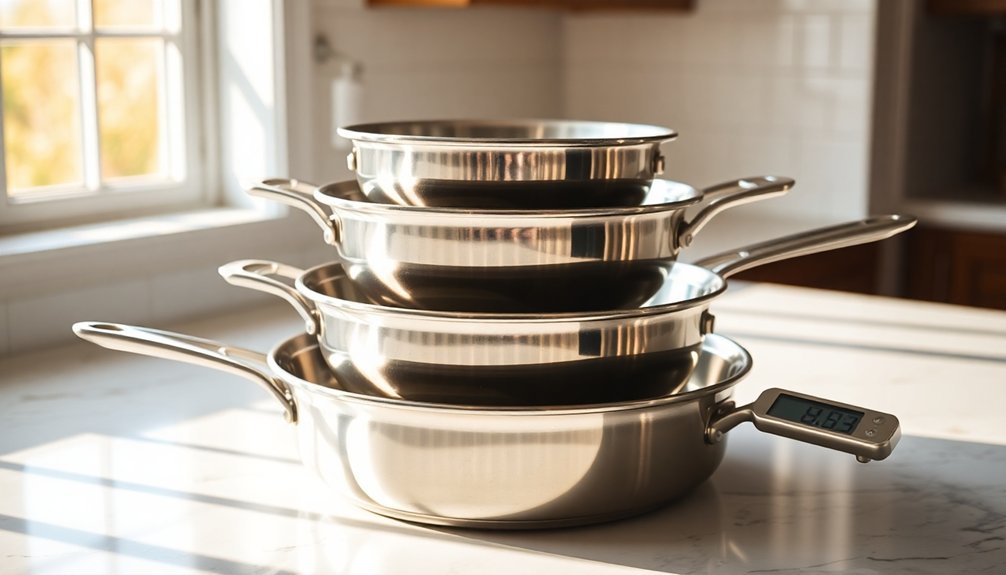
When you're cooking with deep pans, you'll notice they often struggle with uneven heat distribution, creating problematic hot spots that can affect your food's consistency.
These heat distribution issues mean you'll need to invest more time in the cooking process, as deep pans typically take longer to reach and maintain proper temperatures.
You'll also find yourself spending extra time stirring and monitoring your food to compensate for these heating irregularities, especially if your heat source isn't powerful enough.
Heat Distribution Problems
Deep pans, while versatile for many cooking tasks, present considerable heat distribution challenges that can compromise your meal's quality.
You'll notice uneven cooking when your pan doesn't sit flat on the heat source, creating frustrating cold spots throughout your dish. The problem becomes more pronounced with gas stoves, as high flames tend to heat the outer edges more intensely than the center.
Your choice of pan material greatly impacts heat distribution. While cast iron offers durability, it won't distribute heat as evenly as copper or aluminum alternatives.
You'll achieve better results by properly preheating your pan for 5-8 minutes and using an appropriately sized burner.
If you're using a deep pan with a gas stove, consider a heat diffuser to help spread the heat more uniformly across the cooking surface.
Longer Cooking Required
Beyond heat distribution concerns, the extended cooking time required for deep pans can greatly impact your meal preparation. You'll notice up to 60% decreased efficiency when using deeper pans compared to shallower alternatives. The volume of food and liquid directly affects your cooking duration.
| Factor | Impact on Cooking Time |
|---|---|
| Weather | Cloudy days slow cooking |
| Wind | Causes heat loss & delays |
| Pan Load | Fuller pans cook slower |
When you're using a deep pan, you'll need ideal sun conditions for effective cooking. To optimize your solar cooking experience, consider using multiple smaller, shallower pans instead of one deep container. You'll also want to minimize liquid usage, as water's density markedly extends cooking duration. Remember that frequent uncovering of your cooking pot will let precious heat escape, further extending your cooking time.
Pan Material Impact Analysis
Understanding a pan's material composition is vital for achieving ideal cooking results, as different metals and alloys exhibit distinct thermal properties.
You'll find that thicker pans made from high-conductivity metals like aluminum or copper distribute heat more evenly across your cooking surface.
For optimal sun-powered baking, consider these material characteristics:
- Aluminum's excellent conductivity guarantees quick and uniform heat distribution
- Copper provides superior heat control but comes at a higher cost
- Cast iron retains heat longer due to its mass, ideal for consistent temperatures
- Multi-clad stainless steel combines durability with improved heat distribution
- Non-stick coatings may affect heat transfer and require temperature monitoring
The thickness of your pan matters as much as its material – thicker pans maintain steadier temperatures and reduce hot spots, vital for successful solar baking.
Heat Transfer Across Pan Depths
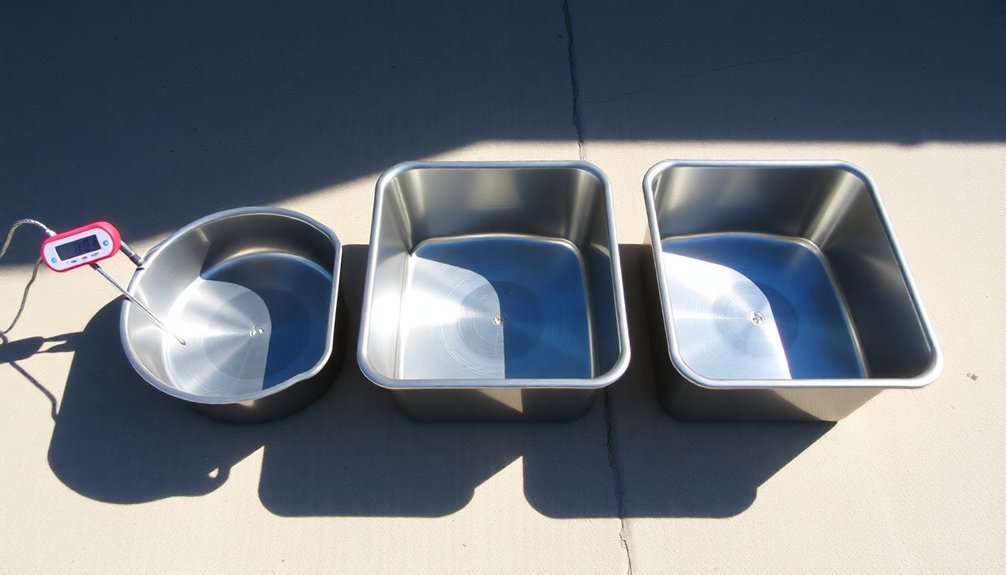
When cooking with nested pans, heat transfer dynamics play an essential role in maintaining consistent temperatures throughout your dish. You'll find that deeper pans filled with more hot water retain heat longer due to increased volume, while the gap between your water pan and food pan should be minimal for efficient heat transfer.
| Pan Depth | Heat Retention | Heat Transfer Method |
|---|---|---|
| Shallow | Lower | Mainly Conduction |
| Medium | Moderate | Conduction/Convection |
| Deep | Higher | All Three Methods |
| Double-Jacketed | Highest | Enhanced Insulation |
To maximize heat retention, you'll want to take into account using perforated insert pans that allow steam to directly contact your food. Double jacketing the bottom pan and wrapping the setup in insulating materials will further reduce heat loss to the environment. Remember to replace cooled water with boiling water to maintain consistent cooking temperatures.
Adapting Traditional Pans
Since traditional cookware wasn't designed for solar cooking, you'll need to make strategic adaptations to your existing pans for peak performance. You can transform your regular pans by painting them with non-toxic dark paint to enhance heat absorption. If you're using metal pans, make sure they're thin and shallow for better heat distribution.
When adapting your cookware for solar cooking, consider these essential modifications:
- Add well-fitting lids or use heat-safe plastic wrap to trap heat
- Place pots inside high-temperature baking bags for improved insulation
- Avoid aluminum foil covers that reflect sunlight away
- Choose shallow containers over deep ones for even cooking
- Position handles so they don't cast shadows on the cooking surface
Remember to regularly reposition your adapted cookware to follow the sun's movement for ideal results.
Testing Pan Performance
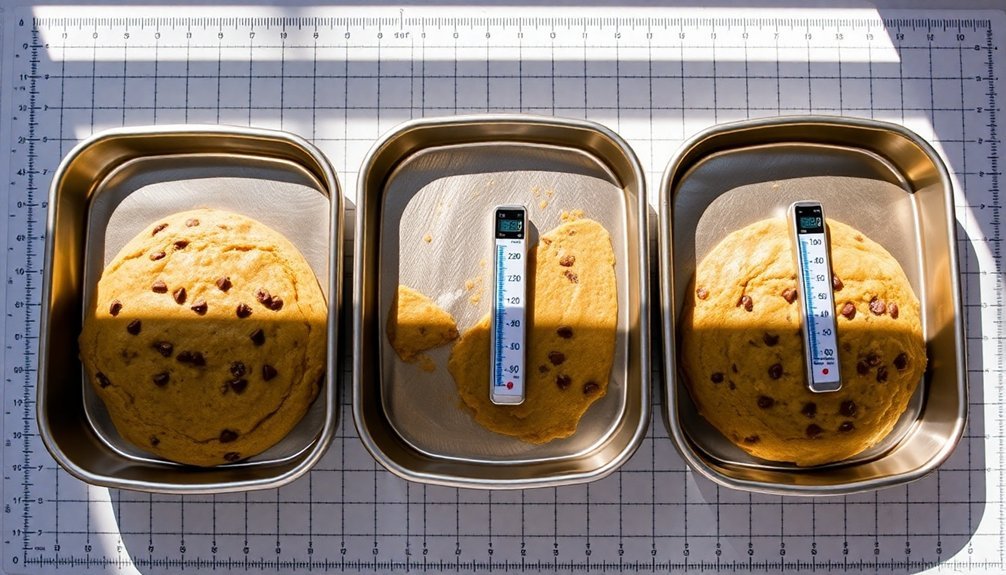
Testing your solar cooking pans requires following rigorous scientific protocols to guarantee accurate performance measurements.
You'll need to conduct tests between 10:00 and 14:00 solar time, when ambient temperatures range from 20-35°C and wind speeds stay below 1.0 m/s.
To evaluate pan performance, you'll fill each vessel with 7,000 grams of water per square meter of intercept area.
Paint your pans black to maximize heat absorption.
Record water temperatures every 10 minutes to the nearest 0.1°C, along with solar insolation and weather conditions.
You must track the sun's movement by adjusting your cooker in two dimensions for concentrating models or rotating horizontally for box-type cookers.
The data you collect will help determine cooking power through regression analysis, revealing how effectively your pan depths perform.
Solar Baking Time Adjustments
When using a solar oven, you'll need to double your standard recipe times and account for weather fluctuations that can extend cooking duration even further.
You should consistently check your food's internal temperature, as varying sunlight intensity throughout the day affects how quickly items cook.
Keep in mind that cloudy conditions will greatly slow your baking progress, while clear, sunny days allow for more predictable cooking times.
Doubling Standard Recipe Times
Although conventional recipes serve as useful starting points, you'll need to adapt your cooking times considerably when using a solar oven. You can expect cooking durations to be two to four times longer than traditional methods, but don't worry about burning your food – solar ovens rarely overcook dishes.
For successful solar cooking, remember these essential timing adjustments:
- Monitor your oven's temperature using a reliable gauge
- Realign your oven every 30-45 minutes for ideal sun exposure
- Preheat for 30-60 minutes before adding food
- Use dark-colored pans to maximize heat absorption
- Check food periodically to assess cooking progress
When temperatures run lower than conventional recipes specify, simply extend your cooking time rather than modifying ingredients.
Keep track of your timing adjustments for future reference, and you'll soon master solar cooking schedules.
Weather Impact on Baking
Successful solar baking requires careful attention to weather conditions and seasonal changes.
You'll achieve the best results between 11:00 am and 3:00 pm when UV rays are strongest. During winter, expect temperatures to max out at 250-300°F, while summer offers more flexibility with longer unattended cooking periods.
Cloud cover greatly impacts your baking time. You'll need to double your cooking duration on partially cloudy days, and very overcast conditions may require heat-retention bags.
To maintain ideal temperatures, position your oven at a 90-degree angle to the sun and adjust it every 20-45 minutes. Use a Lazy Susan for easier rotation, and check that the shadow behind your cooker stays symmetrical.
Remember to protect your oven from wind and use proper insulation like cotton balls or newspapers to maintain consistent heat.
Monitor Internal Food Temperature
Precise temperature monitoring makes or breaks your solar baking results.
You'll need reliable tools like thermocouples and data loggers to track internal food temperatures accurately. Using buffered probe sensors provides more precise readings than measuring air temperature alone.
Your success depends on real-time monitoring and quick adjustments. Track your solar oven's performance with these essential steps:
- Use a meat thermometer to check food doneness
- Place temperature sensors in different zones to identify hot spots
- Monitor heat retention during cloud cover changes
- Track temperature data through mobile apps
- Calibrate your sensors regularly for reliability
When temperatures run lower than expected, you'll need to extend cooking times.
Remember to rotate your oven every 20-45 minutes to follow the sun, and use dark, non-reflective pots for ideal heat absorption.
Seasonal Pan Depth Considerations
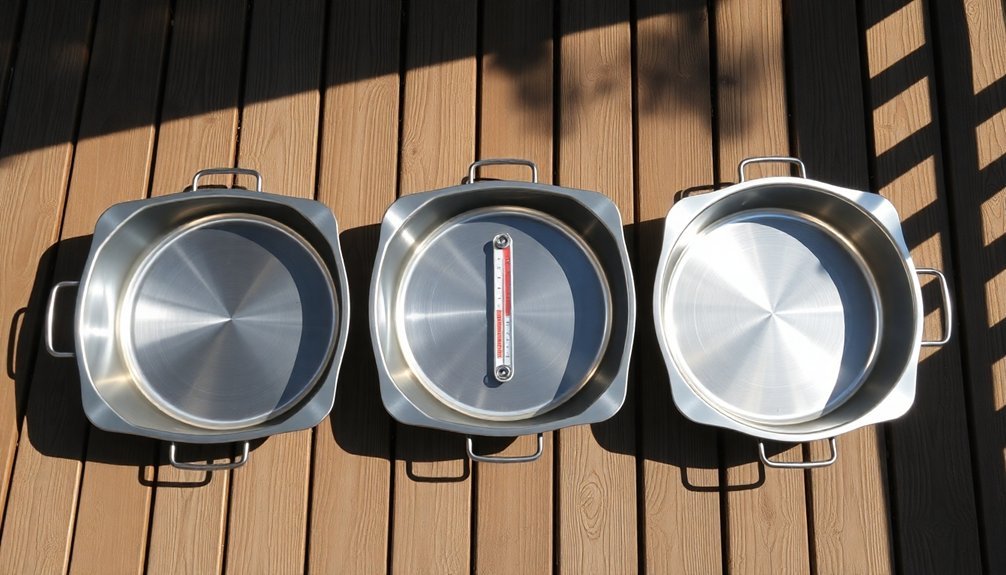
When baking throughout the year, pan depth plays an essential role in achieving consistent results across changing seasons.
You'll need to adjust your baking times and temperatures based on your pan's depth and the current season. Deep pans require longer baking times at lower temperatures to guarantee even cooking, while shallow pans can handle higher temperatures due to their thinner batter distribution.
You'll also want to take into account how seasonal humidity affects your pan's heat conductivity. Dark metal pans brown faster, and glass pans need a 25°F temperature reduction.
Remember that specialty pans like Bundts and loaf pans have unique requirements. They need denser batters and longer baking times.
Don't forget to monitor your oven's temperature with a thermometer, as seasonal changes can affect its performance.
Pan Selection Guidelines
Choosing the right pan for solar cooking requires careful consideration of both material and design elements.
You'll want to select dark-colored cookware that absorbs sunlight efficiently while avoiding reflective metal surfaces that deflect heat away from your food.
For ideal performance, consider these essential guidelines:
- Pick thin-walled, enameled metal pans that heat up quickly
- Select pans with similar top and bottom diameters for even heat distribution
- Use non-toxic, dark paint if modifying existing cookware
- Match pan size to food volume to prevent wasted space
- Confirm your pan has a tight-fitting lid for heat retention
When positioning your pan, you'll need to adjust its angle throughout the day to maximize sun exposure.
Remember that solar cooking typically requires less water than conventional methods, so adjust your recipes accordingly.
Frequently Asked Questions
Can I Stack Multiple Shallow Pans to Cook Different Dishes Simultaneously?
Yes, you can stack multiple shallow pans to cook different dishes at once. It's efficient and saves space. Just verify your pans are compatible for stacking and allow proper heat circulation between layers.
How Do Vintage Cast Iron Pans Perform in Solar Ovens?
You'll find vintage cast iron pans work well in solar ovens. They're excellent at retaining heat once warmed up, though they'll take longer to heat initially. Their seasoned black surface helps absorb solar energy effectively.
Does Pan Color Affect Cooking Time Differently at Various Altitudes?
Yes, your pan's color affects cooking times differently at various altitudes. Dark pans absorb heat faster, so you'll need shorter baking times and lower temperatures, especially at high altitudes where overbaking is already a concern.
Should Pan Depths Be Adjusted When Cooking at Different Humidity Levels?
You don't need to adjust pan depths for different humidity levels. Instead, focus on managing the cooking environment by using water trays and proper ventilation to control humidity's effects on your cooking process.
Can Magnetic Cookware Interfere With Solar Cooking Effectiveness?
No, your magnetic cookware won't interfere with solar cooking effectiveness. The magnetic properties of pots and pans don't affect solar energy absorption or heat retention, as solar cooking doesn't rely on magnetic fields.
In Summary
You'll find that pan depth considerably impacts your solar baking success. Choose shallow pans (1-2 inches deep) for even heat distribution and faster cooking times. Remember that your pan's material matters just as much as its depth – dark, non-reflective surfaces absorb heat better. During winter months, you'll want to stick with shallower pans to maximize limited sunlight. Test different depths to discover what works best for your climate.
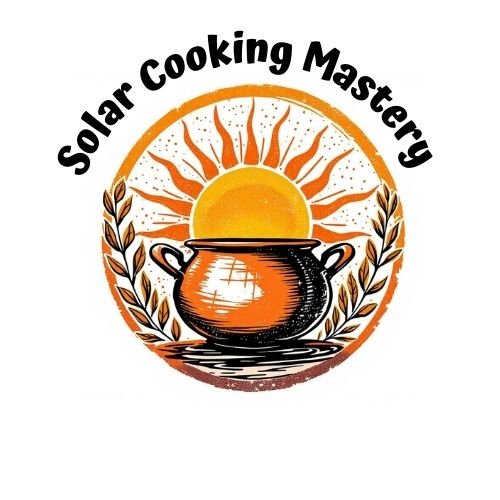
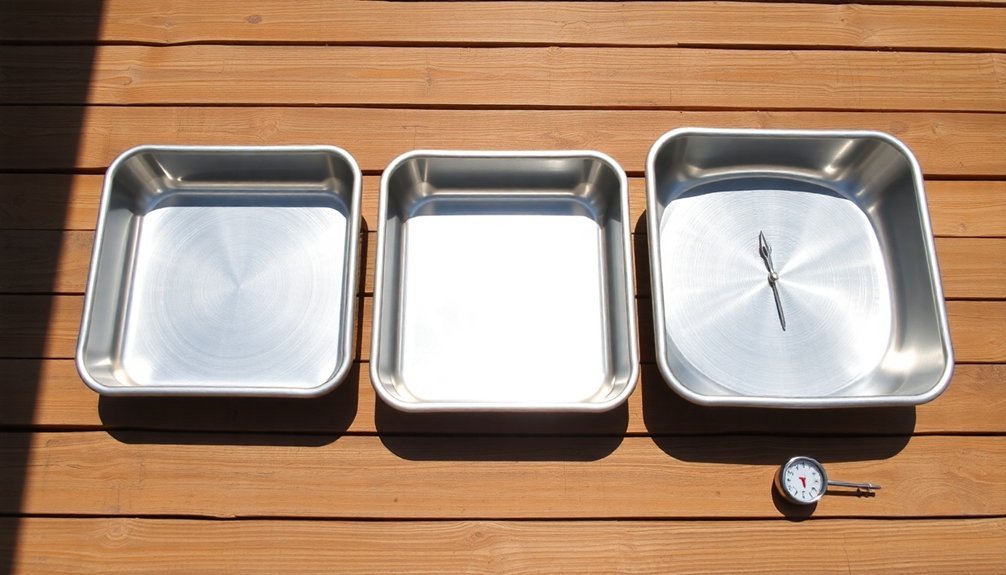
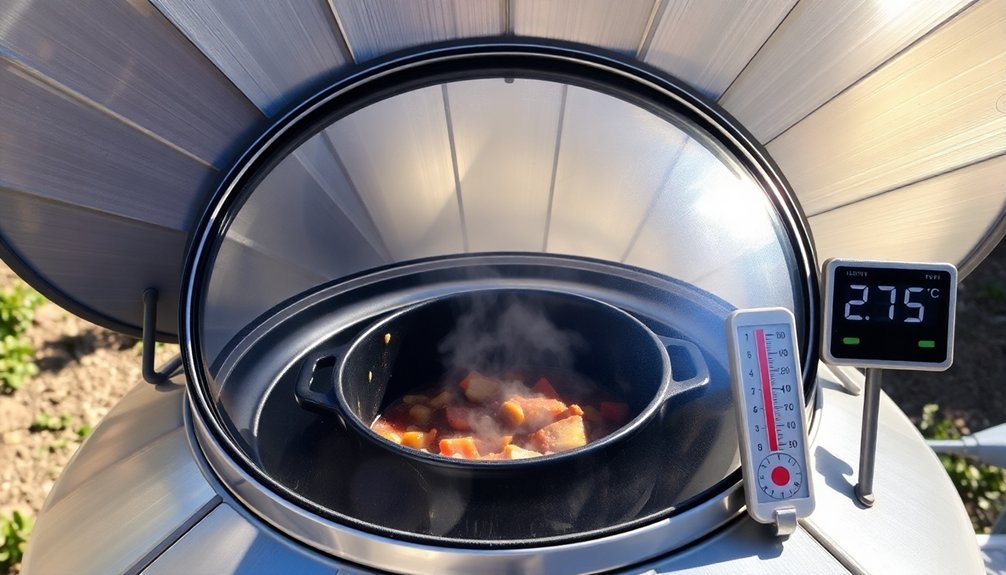
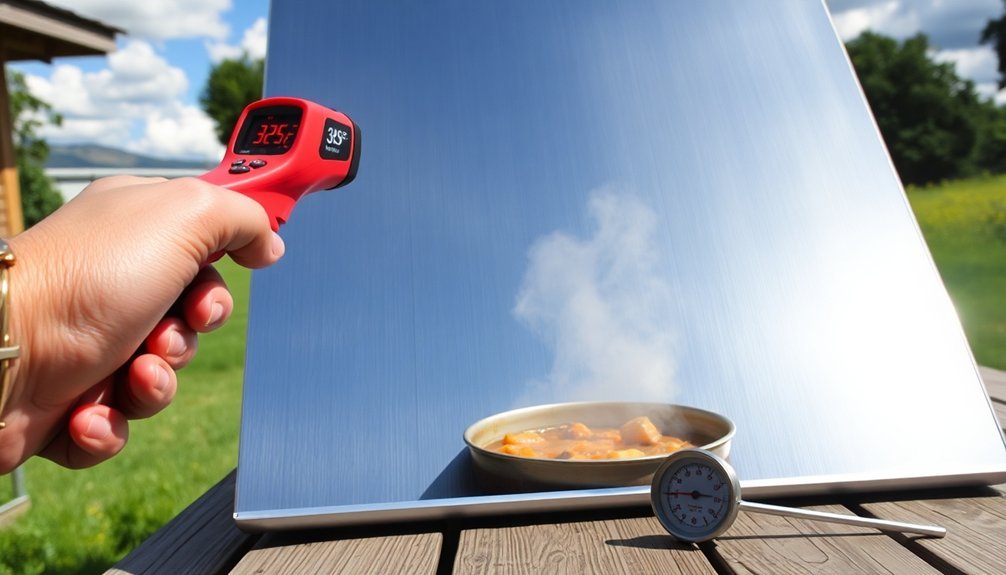
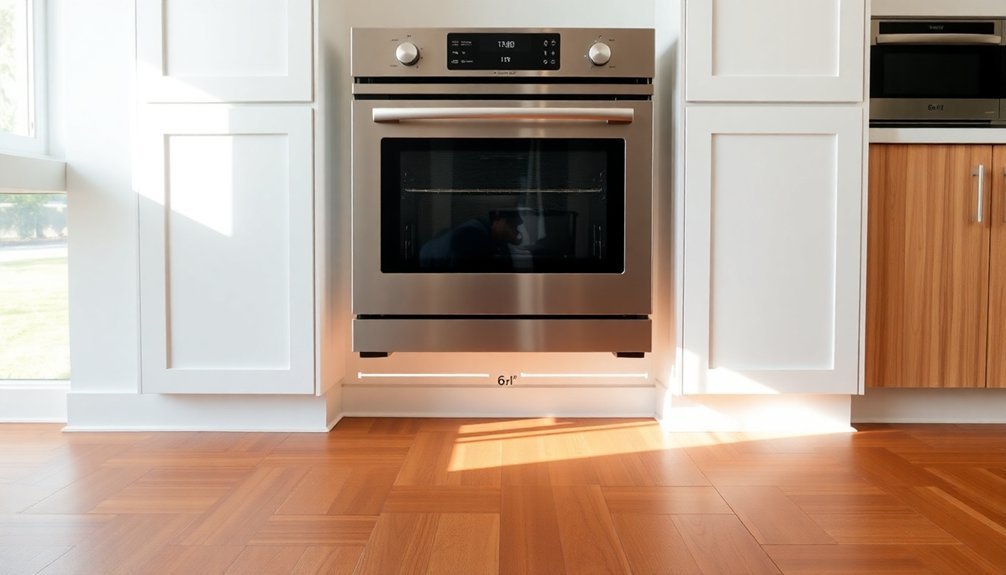
Leave a Reply